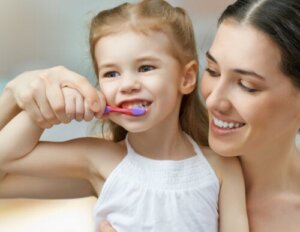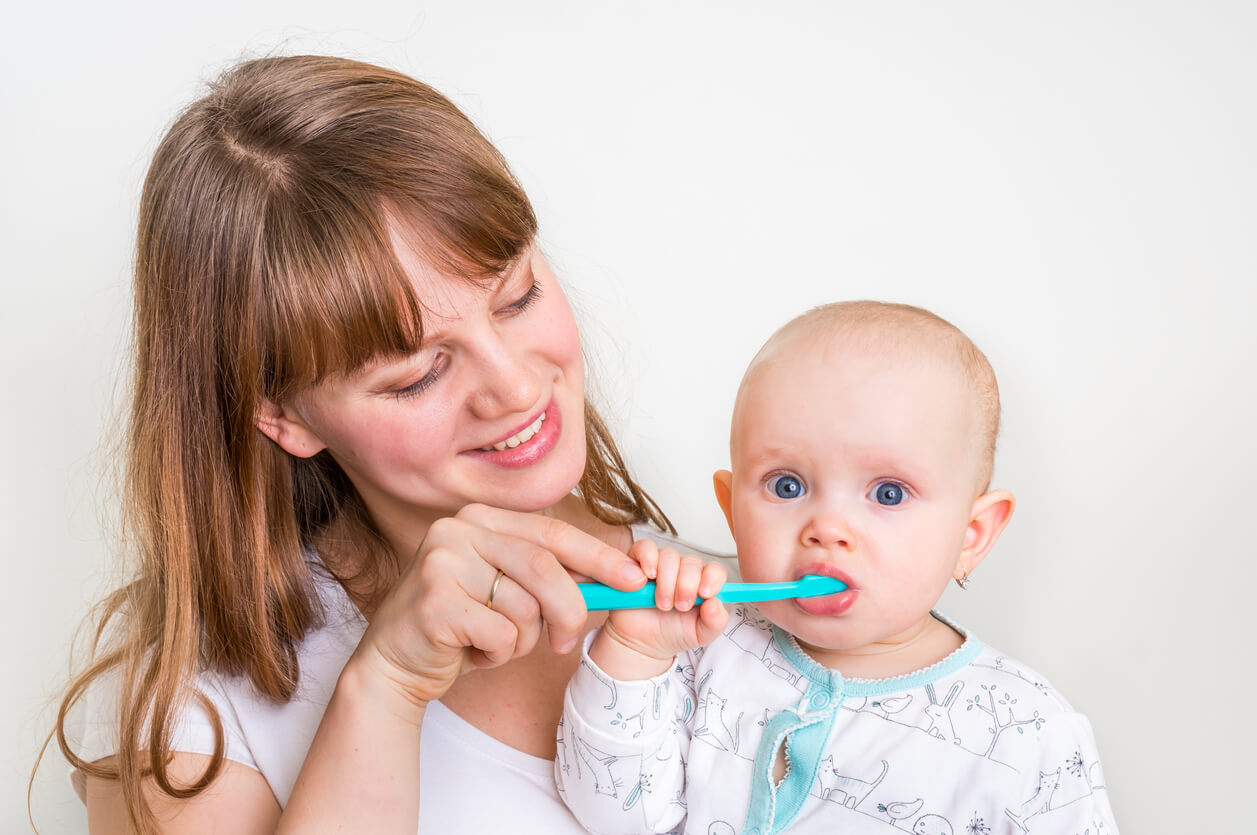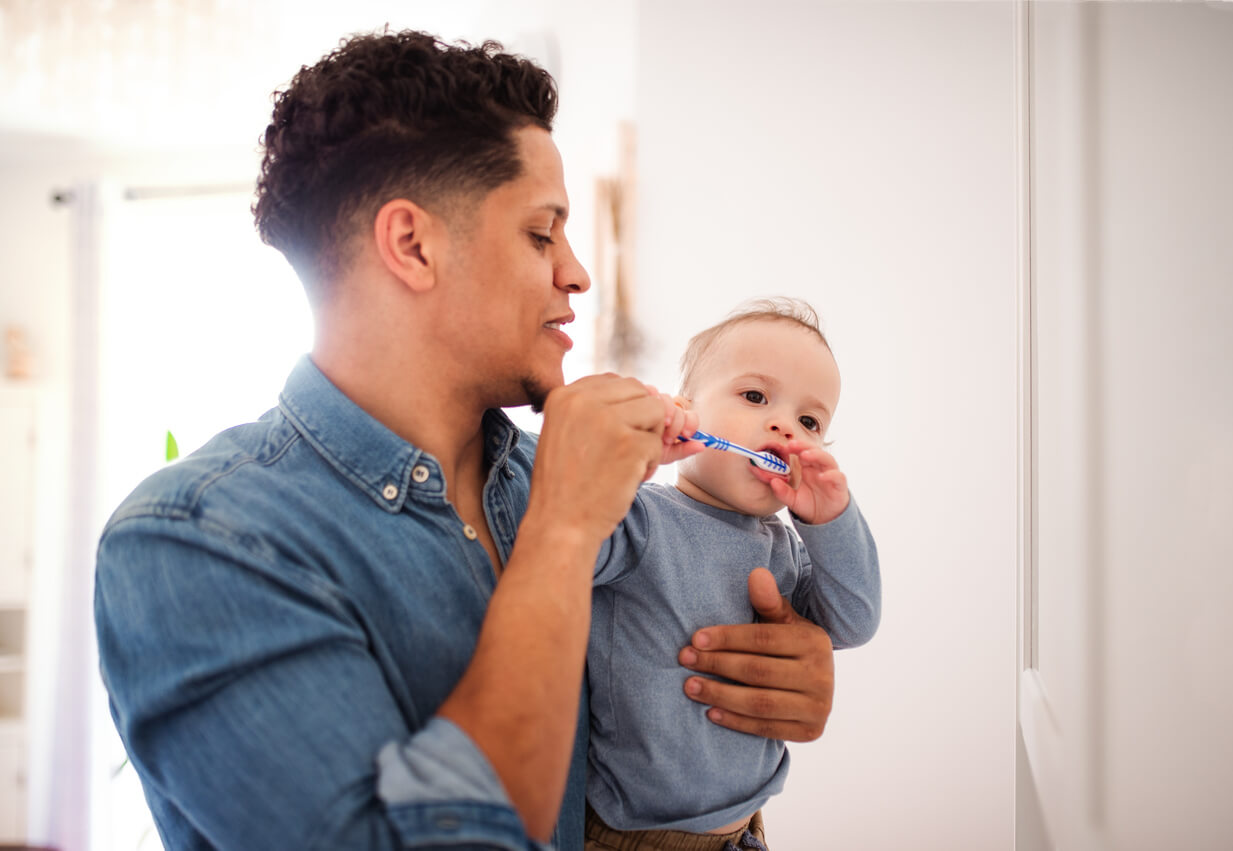Guidelines for Proper Tooth Brushing in Children


Written and verified by the dentist Vanesa Evangelina Buffa
Taking care of children’s oral hygiene is an investment in their health. In this article, we’ll offer you some guidelines for proper tooth brushing in children so that their mouths are healthy and cared for.
Starting to clean children’s mouths from an early age prevents many of the most common oral problems, such as cavities, gingivitis, and bad breath. This habit also teaches children about the importance of taking care of their own health.
When children are young, adults should be responsible for cleaning their mouths. Then, as they grow up, parents should teach them how to do it themselves and continue to accompany them in the task. Discover this complete guide on dental hygiene in children.
When to start brushing children’s teeth?
Cleaning children’s mouths should begin at an early age, even before the first teeth appear. When there are no teeth yet, the baby’s gums and tongue should be cleaned by wiping them with a clean, damp cloth or a silicone swab.
As soon as the first teeth appear, it’s time to start cleaning with a toothbrush. Look for an appropriate instrument for the size of the baby’s mouth, with a small brush head and soft bristles. In addition, brushing should be complemented with a small amount of fluoride toothpaste. As children grow and learn to spit, this amount is increased.

How many times a day should children’s teeth be brushed?
Ideally, brushing should be done after every meal. However, this isn’t always possible. Therefore, make sure that your child receives two or three correct and thorough cleanings per day to help preserve their teeth healthy.
Proper tooth brushing at night is the most important, as, during sleep, the production of saliva is reduced and this favors the proliferation of bacteria. Going to sleep with a clean mouth reduces the risk of harmful germs accumulating.
What’s the ideal toothbrush for proper tooth brushing in children?
When it comes to proper toothbrushing in children, the instruments to be used are of utmost importance. You should choose an element that’s comfortable. Children’s toothbrushes come in different sizes and designs according to their age. In addition, the bristles should be soft and smooth so that they don’t cause trauma to the gums.
Children can participate in choosing their own toothbrush, which can stimulate them to take an interest in oral health care. At the same time, according to the American Dental Association (ADA), children’s toothbrushes, or toothbrush heads in the case of electric toothbrushes, should be changed every 3 to 4 months. Also, they should be replaced with a new one if they show signs of deterioration, the bristles are too open, or the child has had an infection.
How to brush children’s teeth correctly
Once a baby’s first teeth appear, it’s time to start brushing them to keep them clean and healthy. Proper tooth brushing isn’t only important to prevent oral diseases in children, but it also helps them learn this task and incorporate it into their daily routine.
Proper tooth brushing, step by step
Knowing what to do and how to do it will allow you to take care of your child’s oral hygiene properly. Here’s a step-by-step guide to proper toothbrushing for children.
- Prepare the toothbrush with fluoride toothpaste: Depending on the age of the child, place a small amount on the bristles of the toothbrush.
- Find a comfortable position: This will depend on the age of the child and what works best for each family. Some alternatives are to sit the child on your lap, stand the child on a bench so that they’re higher up, or bend down to be at the same height.
- Brushing the outside of the teeth: The toothbrush is placed at an angle, at the junction of the tooth and gums, and rotating and sweeping movements are made. The direction is from top to bottom on the upper teeth and from bottom to top on the lower teeth.
- Brush the inner side of the teeth: In the same way, the sides closest to the palate and the tongue should be sanitized. For the front teeth, the brush can be placed in a vertical position and swept from the inside out.
- Clean the chewing surfaces: With back-and-forth movements, clean the occlusal surfaces of the upper and lower molars on both sides.
- Teach the child to spit out the paste and not to swallow it: At the end of brushing, the child can be offered a glass of water to rinse the mouth and eliminate the debris by salivating.
- Clean the tongue surface: With sweeping movements from back to front, the dorsal side of the tongue should be brushed several times.
Proper tooth brushing in children should last between 2 and 3 minutes. With this, we ensure a thorough and complete cleaning. To complement oral hygiene, depending on the age of the child, other specific products such as mouthwashes, dental floss, or interdental brushes can be used.

Facilitating proper tooth brushing in children
To facilitate children’s acceptance of oral hygiene, it’s helpful to explain to them the importance of brushing. They can understand and commit to taking care of their own health if they’re aware of the risks involved in not taking care of their mouth.
Creating a ritual and letting them participate in certain activities, such as rinsing the toothbrush or turning off the faucet, engages them more in the task. Making brushing time fun, with games, songs, or challenges also encourages them to become more involved with this practice. Also, if children see their parents brushing their teeth every day, it will motivate them to imitate them.
The help of a pediatric dentist is important
In addition to oral hygiene care at home, it’s always a good idea to have the advice of a pediatric dentist to supervise and accompany the process at each stage. Taking children to dental checkups every six months allows a professional to make sure that everything is going well and to improve whatever needs more attention.
Taking care of children’s oral hygiene is an investment in their health. In this article, we’ll offer you some guidelines for proper tooth brushing in children so that their mouths are healthy and cared for.
Starting to clean children’s mouths from an early age prevents many of the most common oral problems, such as cavities, gingivitis, and bad breath. This habit also teaches children about the importance of taking care of their own health.
When children are young, adults should be responsible for cleaning their mouths. Then, as they grow up, parents should teach them how to do it themselves and continue to accompany them in the task. Discover this complete guide on dental hygiene in children.
When to start brushing children’s teeth?
Cleaning children’s mouths should begin at an early age, even before the first teeth appear. When there are no teeth yet, the baby’s gums and tongue should be cleaned by wiping them with a clean, damp cloth or a silicone swab.
As soon as the first teeth appear, it’s time to start cleaning with a toothbrush. Look for an appropriate instrument for the size of the baby’s mouth, with a small brush head and soft bristles. In addition, brushing should be complemented with a small amount of fluoride toothpaste. As children grow and learn to spit, this amount is increased.

How many times a day should children’s teeth be brushed?
Ideally, brushing should be done after every meal. However, this isn’t always possible. Therefore, make sure that your child receives two or three correct and thorough cleanings per day to help preserve their teeth healthy.
Proper tooth brushing at night is the most important, as, during sleep, the production of saliva is reduced and this favors the proliferation of bacteria. Going to sleep with a clean mouth reduces the risk of harmful germs accumulating.
What’s the ideal toothbrush for proper tooth brushing in children?
When it comes to proper toothbrushing in children, the instruments to be used are of utmost importance. You should choose an element that’s comfortable. Children’s toothbrushes come in different sizes and designs according to their age. In addition, the bristles should be soft and smooth so that they don’t cause trauma to the gums.
Children can participate in choosing their own toothbrush, which can stimulate them to take an interest in oral health care. At the same time, according to the American Dental Association (ADA), children’s toothbrushes, or toothbrush heads in the case of electric toothbrushes, should be changed every 3 to 4 months. Also, they should be replaced with a new one if they show signs of deterioration, the bristles are too open, or the child has had an infection.
How to brush children’s teeth correctly
Once a baby’s first teeth appear, it’s time to start brushing them to keep them clean and healthy. Proper tooth brushing isn’t only important to prevent oral diseases in children, but it also helps them learn this task and incorporate it into their daily routine.
Proper tooth brushing, step by step
Knowing what to do and how to do it will allow you to take care of your child’s oral hygiene properly. Here’s a step-by-step guide to proper toothbrushing for children.
- Prepare the toothbrush with fluoride toothpaste: Depending on the age of the child, place a small amount on the bristles of the toothbrush.
- Find a comfortable position: This will depend on the age of the child and what works best for each family. Some alternatives are to sit the child on your lap, stand the child on a bench so that they’re higher up, or bend down to be at the same height.
- Brushing the outside of the teeth: The toothbrush is placed at an angle, at the junction of the tooth and gums, and rotating and sweeping movements are made. The direction is from top to bottom on the upper teeth and from bottom to top on the lower teeth.
- Brush the inner side of the teeth: In the same way, the sides closest to the palate and the tongue should be sanitized. For the front teeth, the brush can be placed in a vertical position and swept from the inside out.
- Clean the chewing surfaces: With back-and-forth movements, clean the occlusal surfaces of the upper and lower molars on both sides.
- Teach the child to spit out the paste and not to swallow it: At the end of brushing, the child can be offered a glass of water to rinse the mouth and eliminate the debris by salivating.
- Clean the tongue surface: With sweeping movements from back to front, the dorsal side of the tongue should be brushed several times.
Proper tooth brushing in children should last between 2 and 3 minutes. With this, we ensure a thorough and complete cleaning. To complement oral hygiene, depending on the age of the child, other specific products such as mouthwashes, dental floss, or interdental brushes can be used.

Facilitating proper tooth brushing in children
To facilitate children’s acceptance of oral hygiene, it’s helpful to explain to them the importance of brushing. They can understand and commit to taking care of their own health if they’re aware of the risks involved in not taking care of their mouth.
Creating a ritual and letting them participate in certain activities, such as rinsing the toothbrush or turning off the faucet, engages them more in the task. Making brushing time fun, with games, songs, or challenges also encourages them to become more involved with this practice. Also, if children see their parents brushing their teeth every day, it will motivate them to imitate them.
The help of a pediatric dentist is important
In addition to oral hygiene care at home, it’s always a good idea to have the advice of a pediatric dentist to supervise and accompany the process at each stage. Taking children to dental checkups every six months allows a professional to make sure that everything is going well and to improve whatever needs more attention.
All cited sources were thoroughly reviewed by our team to ensure their quality, reliability, currency, and validity. The bibliography of this article was considered reliable and of academic or scientific accuracy.
- Bernal, M. D. L. A. M. (2019). SALUD BUCODENTAL EN EL BEB E. El monstruo de Einstein: la primera imagen de un agujero negro, 6(2), 24.
- Morata Alba, J., & Morata Alba, L. (2019). Salud bucodental en los niños:¿ debemos mejorar su educación?. Pediatría Atención Primaria, 21(84), e173-e178.
- Acosta-Andrade, A., David-Solórzano, J., Pico-Sornoza, A., Sinchiguano-Quinto, K., & Zambrano-Torres, J. (2021). Correcto cepillado dental en niños: Artículo de revisión bibliográfica. Revista Científica Arbitrada en Investigaciones de la Salud GESTAR. ISSN: 2737-6273., 4(7), 2-22.
- Nanaxhi, G. B., Saraí, H. R. A., Marlene, C. G., & Nora, P. P. (2020). Errores de Cepillado Bucal más Frecuentes en Niños de la primaria Juan Escutia de Oaxaca. Revista Espacio Universitario. Año, 15(39), 53.
- Sánchez García, M. N. (2021). SALUD BUCAL Y ENFOQUE DE LA ATENCIÓN ODONTOLÓGICA EN BEBES.
- Cárdenas, S. D. LA SALUD BUCAL DEL BEBÉ EMPIEZA DESDE EL EMBARAZO. Facultad de Enfermería Programa de Enfermería Universidad de Cartagena, 12.
- Gutiérrez, D. L. T., Delgadillo, C. B., Ávila, A. J. M., & Rodríguez, M. M. (2022). Protocolo de atención dental para el bebé. Educación y Salud Boletín Científico Instituto de Ciencias de la Salud Universidad Autónoma del Estado de Hidalgo, 10(20), 57-59
This text is provided for informational purposes only and does not replace consultation with a professional. If in doubt, consult your specialist.








